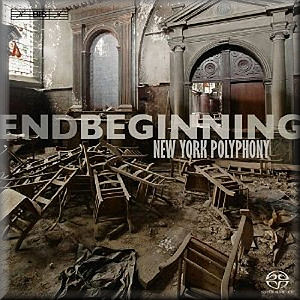 |
 |
|


alternatively
CD: MDT
AmazonUK
AmazonUS
Download
from eClassical |
EndBeginning
Antoine BRUMEL (c.1460-c.1515)
Missa pro defunctis [28:57]
Libera me, Domine (plainsong) [4:22]
Thomas CRECQUILLON (c.1505-57)
Lamentationes Jeremiæ [13:33]
Jacobus CLEMENS NON PAPA (c.1510-c.1555)
Tristitia obsedit me - Infelix ego [8:52]
Josquin DESPREZ (c.1450-1521)
[attrib.]
Absalon fili mi [3:53]
In paradisum (plainsong) [1:15]
Jackson HILL (b.1942)
Ma fin est mon commencement [5:54]
 New York Polyphony (Geoffrey Williams (counter-tenor), Geoffrey
Silver (tenor), Christopher Dylan Herbert (baritone), Craig Phillips
(bass))
New York Polyphony (Geoffrey Williams (counter-tenor), Geoffrey
Silver (tenor), Christopher Dylan Herbert (baritone), Craig Phillips
(bass))
rec. October 2011, Länna Church, Sweden
 BIS BIS-SACD-1949
BIS BIS-SACD-1949  [67:58]
[67:58]
|
|
|
Taking on the legacy of other early music orientated but eminently
flexible vocal groups such as the Hilliard Ensemble, the four
members of New York Polyphony bring to their première
BIS programme a sequence of works which explore themes of grief,
loss and mortality. This review is pre-empted by Brian Wilson’s
May Download
Roundup #1, which sums up the contents of this disc admirably.
The SACD surround element is something you will almost invariably
sacrifice with downloads, so I can add that the sound quality
with the physical disc adds an extra layer of spatial definition
to an already very fine stereo recorded mix. Länna Church
is not a vast sounding acoustic, but suits the unified voices
of New York Polyphony very well indeed. Their sound is warmer
than the Hilliard Ensemble, with the countertenor colouration
far less of a defining factor in the overall impression. In
fact, the rich bass lines from Craig Phillips are if anything
a far more significant factor in this case, with the ear drawn
towards juicy lines which support the harmonies and have their
own expressive role to play in the counterpoint.
Most of the works included in this programme were composed by
masters of the Franco-Flemish school of polyphony from the first
half of the 16th century. Jackson Hill’s contemporary
contribution is a clear exception, and the two examples of plainsong
go back further in time, but the artistic conception of the
whole can be considered a great success. Listening ‘blind’
it is true that the inexpert ear will probably witness a series
of tracks which blend each to the other without too many defining
stylistic features, but with a little attentiveness one can
feel the greater intensity and dissonant density of Thomas Crecquillon’s
Lamentationes Jeremiæ against the more direct but
no less subtle harmonic language of Antoine Brumel’s substantial
and magnificent Missa pro defunctis. Juicy clashes occur
as well in Clemens Non Papa’s Tristitia obsedit me,
ornamental vibrato used by the voices which adds spice to the
sustained notes, allowing lines to emerge and recede without
too much resorting to dynamic contrast alone. One of the most
lyrically expressive pieces is that by Josquin Desprez, or might
it have been Pierre de la Rue’s Absolon fili mi,
the text of each section of which deals with the mourning of
a father for their son.
With such a compact vocal ensemble there is no room for inaccuracy,
and the tightness of the ensemble is evidenced by the short
moments of plainsong, which show absolute accuracy of intonation
and not a consonant out of place. This is very much a ‘single
instrument’. The colour matching of the voices indeed
makes one almost convinced it is one very rich voice one is
hearing in the plainsong, and the impression throughout is of
an ensemble which could be considerable larger. The final work
by Jackson Hill works amongst the earlier pieces for these reasons,
as well as due to its sympathetically conceived layering of
lines and relative melodic restraint. Ma fin est mon commencement
is, despite everything, something of a lonely orphan in this
context, and I would seriously have considered putting at least
one other similarly proportioned contemporary work elsewhere
- probably as an opener - to balance things.
This is a beautifully conceived, performed and produced release,
and I heartily recommend it to all comers. All texts are printed
in the booklet, which has compact but useful notes by Ralph
Buxton in English, German and French. Brian Wilson suggested
that “surely, a better cover shot” might have been
found. I tend to disagree, though my initial response was “that
must have been one heck of an after-party…” We’re
given a website for the source of the picture but some information
in the booklet might have been useful, though I understand if
the exact locations are meant to be kept secret. It is apparently
an abandoned mid-19th century hospital in Belgium,
of which the chapel is one of the few surviving relics. Just
beyond that door is a space which appears still to be in use.
Beauty in decay, loss and abandonment: highly appropriate given
the content of the programme.
Dominy Clements
|
|

